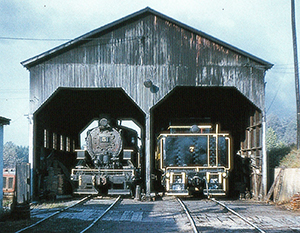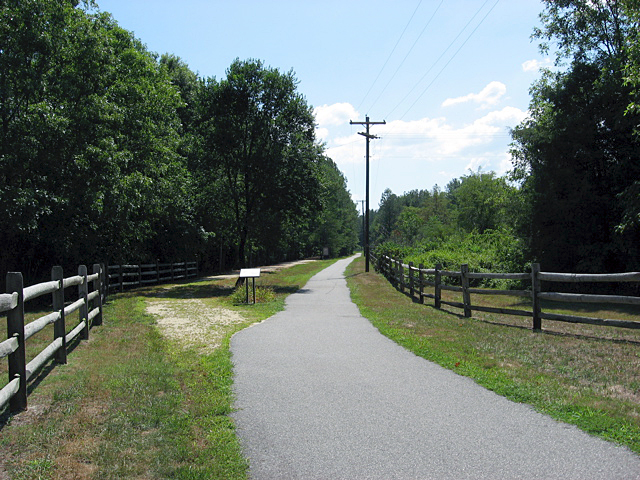Remnants Of The VBR…
After the VBR ceased operations and the rails were ripped up, the former locomotive shop and maintenance buildings at Piney River remained standing, although converted for other uses. With the passing of time there have been many changes along the VBR. In the mid-2000’s the old corrugated sheet-metal and wood-framed enginehouse (dating from the 1930’s) caught fire and was destroyed. A modern replacement of similar dimensions now stands nearby, albeit for non-railroad use.


The wooden Piney River depot still keeps watch over the old right-of-way, as does the VBR’s former corporate office just behind the station. The brick office structure is now a private residence. The depot itself originally had segregated waiting rooms and a freight house section with a platform that has long since been removed. Even the Southern Railway’s station at Tye River disappeared from the scene in the 1970’s when the Southern deemed it more cost-effective to demolish the building and have the freight agent conduct his business by traveling about in a company vehicle.


March 2009.
Photo: Alan Maples


May 1963
Photo: Earle H. Gil, Sr.
Virginia Blue Ridge Railway Trail…Yesterday & Today
The VBR right-of-way is now a hiking and biking trail, known as the Virginia Blue Ridge Railway Trail. The images that accompany this section will showcase several views of the VBR in the past, counter-juxtaposed with images from the current Trail. The Piney River station today serves as the trail headquarters and the accompanying trail head sign, located just opposite the station, is an attractive one with historical significance. The “frame” of the sign consists of two crossties and four sections of rail lifted from the roadbed of VBR itself and set in stone. The logo of the trail is a stylized version of one of the VBR’s iconic 0-6-0 steam locomotives, pulling a cut of cars with the Blue Ridge Mountains rising in the background.




The trail came about in 1997 when The Virginia Blue Ridge Railway Trail Foundation, Inc. was founded by a group of citizens from Virginia’s Nelson and Amherst Counties for the purpose of converting the VBR’s abandoned right-of-way into a hiking trail. Trail foundation members gained support from county governments, local businesses and private individuals. A portion of the former right-of-way of the VBR was held by an adjacent property owner, attorney Stephen C. Martin of Amherst, VA, along with his wife Popie, who was more than willing to donate the roadbed to the Foundation’s cause. In 1999, the first of seven “Transportation Enhancement Grants”, as well as a number of other grants enabled the vision of the trail become a reality.


After six years of planning, fundraising and actual construction, the first portion of the Virginia Blue Ridge Railway Trail opened to the public on June 7, 2003. At that time, the walkway consisted of two trail heads (Piney River and Roses Mill), nearly 2 miles of trail surface, and a renovated 200-foot long bridge. A few years later, additional grants enabled 4 additional bridges to be rebuilt for pedestrian use, as well as clearing the edges of the path and laying down surfacing material to extend the trail from Roses Mill to Tye River.





The hiking trail begins at the old Piney River depot in Nelson County and follows the Piney River itself East 1.8 miles to Roses Mill in Amherst County. Continuing Eastward the trail crosses back into Nelson County 3.5 miles down river just below the confluence of the Piney and Tye Rivers and then passes under Route 29. The pathway wanders through the countryside and presents views of the rolling hills, farms and the waterways. To this day, the route of the VBR offers little evidence of civilization, and retains its bucolic ambiance. Wildlife and flowers are everywhere and the trail is a safe and pleasing experience for all who come to enjoy everything it has to offer.















A February 4, 2012 article in The Daily Progress of Charlottesville, VA noted that a new phase of the VBR Trail Project had commenced. Plans include obtaining, restoring and displaying a caboose at Piney River; putting up 50 signs about the history of the area and the railroad along the trail; preserving one of the VBR’s old dump cars and a handcar; and renovating the Tye River weigh station at the end of the trail and re-installing its scales. The VBR depot at Piney River on Route 151 will be restored and provide a home for exhibits on the history of the railroad and Hurricane Camille. Additional plans include the completion of the last segment of the trail and building a traditional railroad cover for the Naked Creek Bridge.



Tye River Scale House in 1978
Although the Virginia Blue Ridge Railway is now long-gone from the rural Dixie scene, there are still many citizens of the peaceful Nelson County area who fondly cast their minds back through the mists of time to another era. It was a time when one could witness the steam locomotives of “Th’ Blue Ridge” throwing their smokey exhausts high into the air as they struggled to pull heavily-laden freight cars along the banks of the Piney River. A time when the call of the steam whistle could be heard floating and echoing among the hills of the Blue Ridge Mountains and all was right with the world.

A Sincere Thanks to the following individuals who assisted with information, documents and photographs related to the history and operations of the Virginia Blue Ridge Railway:
Kurt R. Bell, Railroad Archivist II; PA State Archives, Harrisburg, PA
Kermit Geary, Sr.
Earle H. Gil, Sr., Collection of Steve Hepler
Theodore F. Gleichmann, Jr.
William T. Greenberg
Walter Grosselfinger
Al Hamilton
John Krause – VBR Black & White Negative Files, Collection of Steve Hepler
Alan W. Maples, President; Everett Railroad, Duncansville, PA
J.C. McHugh, President; McHugh Locomotive & Crane, Fairless Hills, PA
Dave Phraner
Don Ross
Paul M. Saunders, President; Saunders Brothers, Inc., Piney River, VA
Paul Tupaczewski
Suggested Reading:
Heartbeats of Nelson
by Paul M. Saunders
March 2007 – Saunders Publishing, LLC, Piney River, VA
Sentimental Journey – Being a History of the Virginia Blue Ridge Railway
by Carl M. Lathrop
1979 – Carl M. Lathrop, Madison, NJ
Steam Days on the Virginia Blue Ridge Railway
by John J. Hilton & Randolph Kean
1975 National Capitol Historical Museum of Transportation, Inc., Arlington, VA